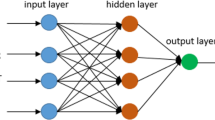Abstract
Wireless sensor networks are employed to monitor physical areas in different places. Fault tolerance and energy efficiency are main challenges of the networks. WSNs are designed to transmit sensed data to the base station when a part of the network is faulty. In this paper, an algorithm is presented to withstand the challenges. In the suggested algorithm, HEED clustering algorithm and sleep/wake-up method are used for the members of cluster to improve energy consumption. To detect and recover the faults of cluster heads and cluster member nodes, a node is selected as backup cluster head. Also, weighted median is employed to detect and recover the faults of cluster nodes. To recover an fault, the faulty node is isolated and replaced by a neighboring node going from sleep mode to wake-up mode. On comparing the proposed algorithm with HEED and DFD algorithms, the results of simulation reveal that energy consumption is improved and the rate of received correct data, detection accuracy and survival nodes are increase and false alarm rate are decrees.








Similar content being viewed by others
References
Yetgin, H., et al. (2017). A survey of network lifetime maximization techniques in wireless sensor networks. IEEE Communications Surveys and Tutorials, 19(2), 828–854.
Rault, T., Bouabdallah, A., & Challal, Y. J. C. N. (2014). Energy efficiency in wireless sensor networks: A top-down survey. Computer Networks, 67, 104–122.
Erol-Kantarci, M., & Mouftah, H. T. (2015). Energy-efficient information and communication infrastructures in the smart grid: A survey on interactions and open issues. IEEE Communications Surveys and Tutorials, 17(1), 179–197.
Jorio, A., & Elbhiri, B. (2018). An energy-efficient clustering algorithm based on residual energy for wireless sensor network. In 2018 renewable energies, power systems & green inclusive economy (REPS-GIE). IEEE.
Leu, J.-S., et al. (2015). Energy efficient clustering scheme for prolonging the lifetime of wireless sensor network with isolated nodes. IEEE Communications Letters, 19(2), 259–262.
Nayak, P., & Devulapalli, A. (2016). A fuzzy logic-based clustering algorithm for WSN to extend the network lifetime. IEEE Sensors Journal, 16(1), 137–144.
Sharma, G., & Sahni, V. (2018). Management, and technology, performance analysis of energy efficient clustering protocolusing tabu in WSN. 15.
Cheng, L., et al. (2018). Towards minimum-delay and energy-efficient flooding in low-duty-cycle wireless sensor networks. Computer Networks, 134, 66–77.
Dong, M., Ota, K., & Liu, A. (2016). RMER: Reliable and energy-efficient data collection for large-scale wireless sensor networks. IEEE Internet of Things Journal, 3(4), 511–519.
Kumar, V. et al. (2018) Optimal clustering in weibull distributed WSNs based on realistic energy dissipation model. In Progress in computing, analytics and networking (pp. 61–73). Berlin: Springer.
Tan, N. D., & Viet, N. D. (2015). SSTBC: Sleep scheduled and tree-based clustering routing protocol for energy-efficient in wireless sensor networks. In 2015 IEEE RIVF international conference on computing and communication technologies-research, innovation, and vision for the future (RIVF). IEEE.
Swain, R. R., Khilar, P. M., & Bhoi, S. K. (2018). Heterogeneous fault diagnosis for wireless sensor networks. Ad Hoc Networks, 69, 15–37.
Won, J., & Bertino, E. (2015). Distance-based trustworthiness assessment for sensors in wireless sensor networks. In International conference on network and system security. Berlin: Springer.
Mitra, S., & Das, A. (2017). Distributed fault tolerant architecture for wireless sensor network. Informatica, 41, 47–59.
Jamjoom, M. M. (2017). EEBFTC: Extended energy balanced with fault tolerance capability protocol for WSN. International Journal Of Advanced Computer Science And Applications, 8(1), 253–258.
Azharuddin, M., & Jana, P. K. (2015). A distributed algorithm for energy efficient and fault tolerant routing in wireless sensor networks. Wireless Networks., 21(1), 251–267.
Wang, J., Liu, B. (2017). Online fault-tolerant dynamic event region detection in sensor networks via trust model. In Wireless communications and networking conference (WCNC). IEEE.
Zhou, Y., et al. (2016). Fault-tolerant multi-path routing protocol for WSN based on HEED. International Journal of Sensor Networks, 20(1), 37–45.
Qiu, M., et al. (2013). Informer homed routing fault tolerance mechanism for wireless sensor networks. Journal of Systems Architecture, 59(4–5), 260–270.
Kaur, M., & Garg, P. (2016). Improved distributed fault tolerant clustering algorithm for fault tolerance in wsn. In 2016 international conference on micro-electronics and telecommunication engineering (ICMETE). IEEE.
Heinzelman, W.R., Chandrakasan, A., & Balakrishnan, H. (2000). Energy-efficient communication protocol for wireless microsensor networks. In Proceedings of the 33rd annual Hawaii international conference on system sciences, 2000. IEEE.
Younis, O., & Fahmy, S. (2004). HEED: a hybrid, energy-efficient, distributed clustering approach for ad hoc sensor networks. IEEE Transactions on Mobile Computing, 3(4), 366–379.
Yang, M., Yang, D., & Huang, C. (2012). An improved HEED clustering algorithm for wireless sensor network. Journal of Chongqing University, 35, 101–106.
Chen, Y., & Son, S. H. (2005). A fault tolerant topology control in wireless sensor networks. In The 3rd ACS/IEEE international conference on computer systems and applications, 2005. IEEE.
Gupta, S.K., Kuila, P., & Jana, P.K. (2016). Energy efficient multipath routing for wireless sensor networks: A genetic algorithm approach. In 2016 international conference on advances in computing, communications and informatics (ICACCI). 2016. IEEE.
Cheraghlou, M. N., Khadem-Zadeh, A., & Haghparast, M. (2017). Increasing lifetime and fault tolerance capability in wireless sensor networks by providing a novel management framework. Wireless Personal Communications, 92(2), 603–622.
Gao, J.-L., Xu, Y.-J., & Li, X.-W. (2007). Weighted-median based distributed fault detection for wireless sensor networks. Journal of Software, 18(5), 1208–1217.
Vieira, T.P., Almeida, P. E., & Meireles, M. R. (2017). Intelligent fault management system for wireless sensor networks with reduction of power consumption. In 2017 IEEE 26th international symposium on industrial electronics (ISIE). IEEE.
Jiang, P. J. S. (2009). A new method for node fault detection in wireless sensor networks. Sensors, 9(2), 1282–1294.
Author information
Authors and Affiliations
Corresponding author
Additional information
Publisher's Note
Springer Nature remains neutral with regard to jurisdictional claims in published maps and institutional affiliations.
Rights and permissions
About this article
Cite this article
Jafarali Jassbi, S., Moridi, E. Fault Tolerance and Energy Efficient Clustering Algorithm in Wireless Sensor Networks: FTEC. Wireless Pers Commun 107, 373–391 (2019). https://doi.org/10.1007/s11277-019-06281-6
Published:
Issue Date:
DOI: https://doi.org/10.1007/s11277-019-06281-6




